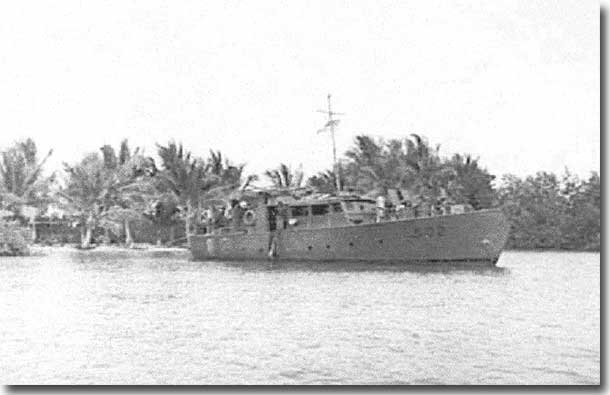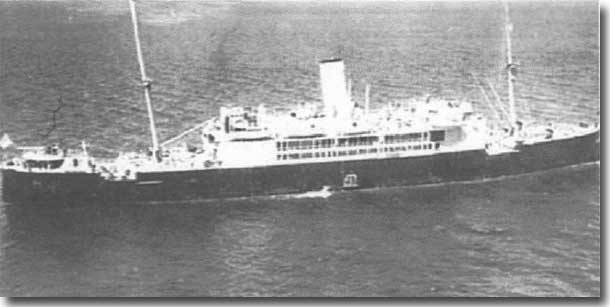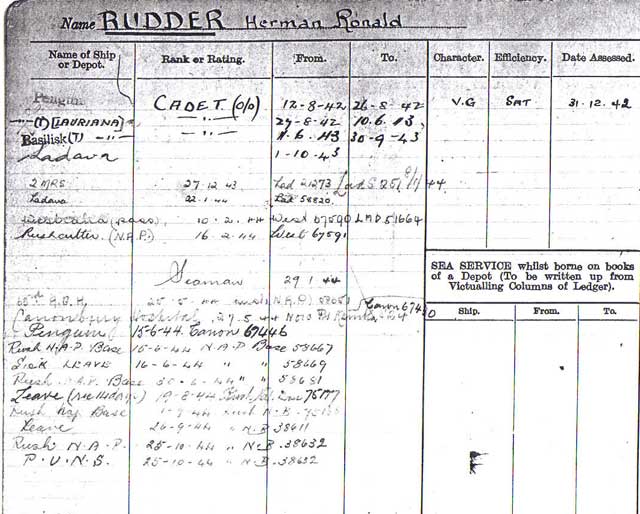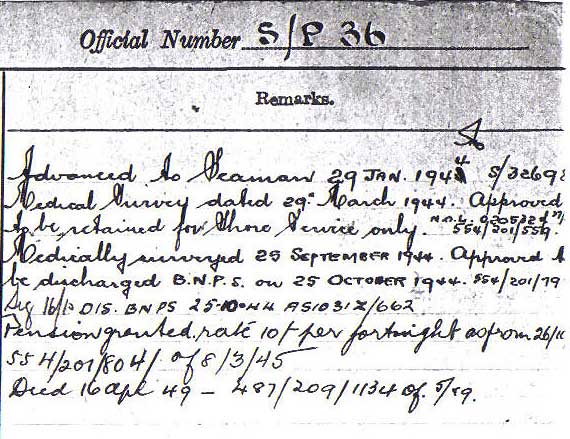|
Letters
Grandfather served in the RAN during WWII. How to interpret a copy of his service record from the National Archives of Australia? Sir:
In response to your E-Mail, here goes: HMAS Penguin was a Naval Depot on Sydney Harbour at Balmoral, on the north side of the harbour, it was used to house Officers and sailors often for a few days when they were en route to a new appointment or ship, it was also a training depot as you have noted. HMAS Lauriana was an air-sea rescue launch that operated in New Guinea under the command of the Royal Australian Air Force, I have found a photograph of her in New Britain in November 1944, and will scan and E-Mail that to you later. Lauriana is mentioned on this page about the attack by Japanese Midget Submarines on Sydney Harbour in 1942.
HMAS Lauriana HMAS Basilisk was the name of the Port Morseby Naval Shore Depot, in New Guinea. HMAS Ladava was the name of the Royal Australian Naval Base at Milne Bay in New Guinea. 2 MRS I am at a loss to explain, but it only covered a time of six days. HMAS Westralia was originally commissioned as an Armed Merchant Cruiser, but then converted to a Landing Ship Infantry in May of 1943. She transported troops to New Guinea and took part in amphibious operations.
HMAS Westralia I suggest the entry under Westralia ( pass ) probably means your wife's Grandfather took passage in the ship. I will scan a photograph of the ship and E-Mail it separately to you. HMAS Rushcutter was a Naval Anti-Submarine training school at Rushcutter Bay on the south side of Sydney Harbour. I believe the 63rd. AGH refers to the 63rd Australian General Hospital in New Guinea, I will E-Mail a page about the 4th US Hospital Unit, in it, there is a section indicating that when they moved to New Guinea they embraced the 63rd. AGH. Cannonbury Hospital, I think may be Canonbury Hospital, in Sydney, and I will send a page describing the history of this building, which was used eventually as a hospital for service people, an annex to the Crown Street Hospital, and eventually knocked over to become a park, Named after a former Premier of New South Wales who then became Governor General of Australia, Sir William McKell, by chance through 1950/1953, I served as his Aide-de-Camp, as a Lieutenant Commander RAN, some coincidence! The fact that your relative had his spells in hospital, was discharged with a Pension, indicates to me that he was certainly wounded, or developed some malady from his war service that was severe enough to firstly keep him ashore, then have him discharged from the RAN. Now David, you did not give me Grandfather's name, but a year or so ago, our Veteran's Affairs Department put up on the internet, a Nominal Roll of a Million names of those who served in WW2. One is able to enter a name on this roll and print out a Certificate of Service for them. Here is what you need to do:
David, I apologise for being so long winded, but felt some detail was needed to give you a satisfactory reply. Expect some more mail to follow this message, if you have any other questions or feel I may be able to assist you further, please ask. Best regards from Down Under,
Thank you so very much for the reply. This information is indeed helpful. My wife’s grandfather’s name was Rudder, Herman Ronald, Service number S/P36. Would it be helpful if I scanned the sheet I was sent, and see if you can recognize some of the details I may not understand? Thanks again for your help in adding some depth and knowledge to my wife’s (and now my) family history.. David R. Wimer
Herman Rudder service card left columns
Herman Rudder service card 1
Here is an extract from: Australia in the War of 1939-1945. Royal Australian Navy 1942-45. by G. Hermon Gill, Canberra, Australian War Memorial. 1968. It is Vol II of the Official History of the RAN, at Page 281: "Milne Bay came into the picture on the 14th. of April ( 1943 ) when, in its twenty-fourth air raid, 40 to 50 bombers and about 60 fighters attacked, and concentrated on ships in the bay. These included the British Gorgon, and Dutch Van Outhoorn, Van Heemskerk, and Balikpapen. The last mentioned two arrived just before the enemy aircraft, escorted by Kapunda ( Lieutenant Commander Dixon ). The corvette brought the tally of her class in Milne Bay for the raid up to three --- Whyalla ( Lieutenant Commander Oom ) and Wagga ( Lieutenant Cracknell ) being already there. Warning of the impending raid, and intimation of its size, were given when the enemy aircraft were approaching over the Trobriands. Commander Branson the Naval Officer in Charge, took advantage of the breathing space personally to tour the harbour in the air - sea rescue launch Lauriana ( my note here, at this time Herman was serving in Lauriana ) dispersing ships and taking all possible precautions to avoid offering targets. The enemy arrived overhead about 12:15, 30 high level bombers in close formation and 10 dive bombers, with an uncertain number of fighters. The high level aircraft opened the attack by dropping a pattern of about 100 bombs right across the anchorage. This, however, had been cleared, so that no ships were lost in this attack. Van Outhoorn suffered damage from near misses by high - level bombers, had 8 killed and 20 wounded, and was succoured by Whyalla, who did a fine job with anti - aircraft fire. Gorgon was hit a number of times by dive bombers, and set on fire, with her engines out of action. Six of her company were killed or died of wounds , and 28 were wounded. Dixon took Kapunda alongside, ran hoses on board and helped with fire fighting and in berthing the ship; and finally took her in tow for the mainland, helped by the James Wallace. Two of Kapunda's officers later recalled that " progress down Milne Bay was slow and erratic while the correct length of tow was found, even with the tug's assistance. Our tow was of six thousand odd gross tons, and we were only nine hundred; furthermore she could only be steered by emergency hand steering aft. China Strait was negotiated safely, though she took one or two frightening sheers. Once clear, she veered three shackles of cable, making the length of tow approximately five hundred and sixty feet. The tug went ahead of us, passed her towing hawser, so that we towed in tandem, a total length of fourteen hundred feet, from the tug's stern to the merchant man's stern... Certainly God was with us, for the next few days the Coral Sea was at its best, smooth as glass, enabling us to average the excellent speed of 7.1 knots from start to finish." In commending Kapunda and her ship's company for their help in saving Gorgon, Branson also praised that ship's Chief Officer James Bruce, Major Brew of the Docks Operating Company and Able Seaman Larkin ( one of the DEMS gunners ) for their removal of an unexploded bomb from among the ship's cargo of ammunition in N0. five lower hold. As stated above, Van Heemskerk arrived in Milne Bay with Kapunda just before the raid--- and there she remained, beached, a total loss, also as a result of dive - bomb hits. She was the first casualty suffered by LILLIPUT, of which she was Stage 28. Wagga put up a gallant fight to save the Dutch ship, going alongside and putting nine hoses and a fire party on board. But the fire had too great a hold, and Van Heemskerk finally blew up at about 5 PM. In this raid apart from the loss and damage to ships, four Allied servicemen were killed, as were 12 of the merchant ships' crews. In all--- servicemen, civilians of the Small Ships Section and ships' crews--- 68 were wounded. Forty four Allied fighters intercepted and the enemy lost ten bombers and three fighters, three of which were victims to anti - aircraft fire. Wagga and Kapunda suffered superficial damage. Of the work of these two and Whyalla on this occasion, Branson remarked in his report: " we were indeed fortunate to have the assistance of the three corvettes." David, I thought you may like to have this record, it gives you the flavour of at least one action that Herman was involved in in 1943. Now if we go to his record, perhaps I can comment on some of the notes there for you:
Now, I cannot find any record of Lauriana being in an action where he may have been wounded, perhaps he contracted Malaria during his service in her in New Guinea, it was a notorious area for that disease, and nearly His Lauriana would, by her function of air-sea rescue work, spend a lot of time secured alongside at a wharf in New Guinea, and Herman would in my judgement, be wide open to catch Malaria. Troops were given Atabren Of course I am only speculating in this regard David, but it may be possible to track down Herman's Naval Medical Records which could unlock this mystery for us. Next week I will contact our Veteran's Affairs Department and find out if we can get hold of his Medical Records. My final comment relates to the pension of 10 shillings per fortnight granted to Herman in March 1945. That was before we went to decimal currency, our money then was Pounds, shillings and pence. 20 shillings made up a pound, and 12 pence made a shilling. When we went to decimal currency 10 shillings was one Dollar. To give you some idea of values, at the start of WW2, I went to sea as a Cadet Midshipman ( in August of 1939 ) my pay was 6 shillings a day, or two pounds two shillings a week. By 1945, I was a Lieutenant RAN and my pay was about 10 Pounds a week, a Sailor, as an Able Seaman, was probably paid about 3 pounds 10 shillings a week, or David, forgive my verbosity, but I have tried to fill in as many gaps as possible for you and your family. I hope it may help just a little, did you manage to get a Certificate of Service for Herman up and printed out alright? Best Regards,
Once again sir my deepest thanks. I have attached the record we received. I hope it comes thru good enough to view. Also my thanks on the information linking the Lauriana mentioned in the midget sub attacks on Sydney and then serving as a rescue vessel later in the war (from your earlier email) I couldn't tell if they were the same vessel or not in some of the web searches I had conducted. Also my thanks for the service you and your comrades gave during these pivotal times in our Nation's histories. David Wimer
Thanks Mac. I was able to get the certificate printed up… One of the things that has been passed on through the family, and something that my mother in law remembers (of course she was a youngster, so the memory isn’t that fresh) is that Herman had some problem with a leg, with a plate or pin in his leg, that was thought to be connected with his Naval service. Incidentally when Herman died in 1949, he had been fishing, and had been washed off the rocks at Long Reef. Family members have thought maybe his previous injury had played some part, in so far as he could not make it back ashore. His body was never recovered. After Herman’s death, my wife’s grandmother never looked into his Naval service, or his time in WWII, as the memory was too painful. I also had thought maybe accessing his medical records could shed some more light on the situation, but didn’t know where to start. Given the circumstances of Herman’s death/disappearance in 1949 it is indeed a family “mystery”. Thank you again for your assistance. I am a police officer/detective by trade, and this is certainly an Dave Wimer
|




